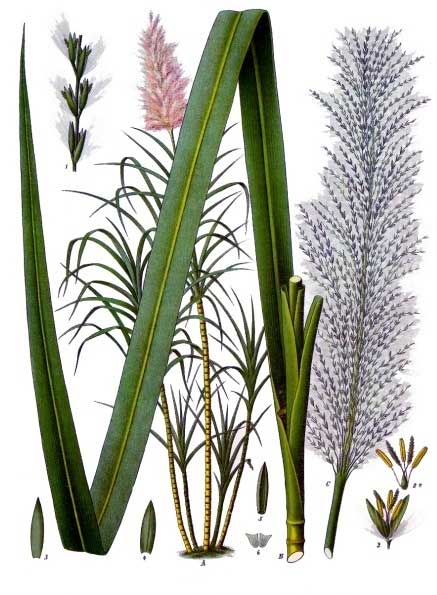
Saccharum officinarum
Classification System: APG IV
Superregnum: Eukaryota
Regnum: Plantae
Cladus: Angiosperms
Cladus: Monocots
Cladus: Commelinids
Ordo: Poales
Familia: Poaceae
Subfamilia: Panicoideae
Tribus: Andropogoneae
Subtribus: Saccharinae
Genus: Saccharum
Species: Saccharum officinarum
Name
Saccharum officinarum L.
References
Linnaeus, C. 1753. Species Plantarum. Tomus I: 54. Reference page.
USDA, ARS, Germplasm Resources Information Network. Saccharum officinarum in the Germplasm Resources Information Network (GRIN), U.S. Department of Agriculture Agricultural Research Service. Accessed: 07-Oct-06.
Vernacular names
Akan: Ahwedeɛ
čeština: Cukrová třtina
Deutsch: Zuckerrohr
English: Sugar cane
suomi: Sokeriruoko, jalosokeriruoko
Nordfriisk: Sokerröör, Sokerraid
français: Canne à sucre
日本語: サトウキビ
polski: cukrowiec lekarski, trzcina cukrowa
Türkçe: Şekerkamışı
Saccharum officinarum is a large, strong-growing species of grass in the genus Saccharum. Its stout stalks are rich in sucrose, a simple sugar which accumulates in the stalk internodes. It originated in New Guinea,[1] and is now cultivated in tropical and subtropical countries worldwide for the production of sugar, ethanol and other products.
Saccharum officinarum is one of the most productive and most intensively cultivated kinds of sugarcane. It can interbreed with other sugarcane species, such as Saccharum sinense and Saccharum barberi. The major commercial cultivars are complex hybrids.[2] About 70% of the sugar produced worldwide comes from S. officinarum and hybrids using this species.[3]
Origin
Further information: Sugarcane § History
Saccharum officinarum was first domesticated in New Guinea and the islands east of the Wallace Line by Papuans, where it is the modern center of diversity. Beginning at around 6,000 BP it was selectively bred from the native Saccharum robustum. From New Guinea it spread westwards to Island Southeast Asia after contact with Austronesians, where it hybridized with Saccharum spontaneum.[4]
Description
Saccharum officinarum, a perennial plant, grows in clumps consisting of a number of strong unbranched stems. A network of rhizomes forms under the soil which sends up secondary shoots near the parent plant. The stems vary in colour, being green, pinkish, or purple and can reach 5 m (16 ft) in height. They are jointed, nodes being present at the bases of the alternate leaves. The internodes contain a fibrous white pith immersed in sugary sap. The elongated, linear, green leaves have thick midribs and saw-toothed edges and grow to a length of about 30 to 60 cm (12 to 24 in) and width of 5 cm (2.0 in). The terminal inflorescence is a panicle up to 60 cm (24 in) long, a pinkish plume that is broadest at the base and tapering towards the top. The spikelets are borne on side branches and are about 3 mm (0.12 in) long and are concealed in tufts of long, silky hair. The fruits are dry and each one contains a single seed.[5][6] Sugarcane harvest typically occurs before the plants flower, as the flowering process causes a reduction in sugar content.[7]
Uses
Portions of the stem of this and several other species of sugarcane have been used from ancient times for chewing to extract the sweet juice. It was cultivated in New Guinea about 8000 years ago for this purpose. Extraction of the juice and boiling to concentrate it was probably first done in India more than 2000 years ago.[5]
Saccharum officinarum and its hybrids are grown for the production of sugar, ethanol, and other industrial uses in tropical and subtropical regions around the world. The stems and the byproducts of the sugar industry are used for feeding to livestock. Pigs fed on sugarcane juice and a soy-based protein supplement produced stronger piglets that grew faster than those on a more conventional diet.[8] As its specific name (officinarum, "of dispensaries") implies, it is also used in traditional medicine both internally and externally.[5]
The Hawaiian word for this species is kō.[9]
See also
Domesticated plants and animals of Austronesia
References
In New Guinea, according to sources cited by Christian Daniels in Joseph Needham, Science and Civilisation in China, Volume 6.3, p. 129ff
Vilela; Del-Bem; et al. (2017). "Analysis of Three Sugarcane Homo/Homeologous Regions Suggests Independent Polyploidization Events of Saccharum officinarum and Saccharum spontaneum". Genome Biology and Evolution. 9 (2): 266–278. doi:10.1093/gbe/evw293. PMC 5381655. PMID 28082603.
"Plants & Fungi: Saccharum officinarum (sugar cane)". Royal Botanical Gardens, Kew. Archived from the original on 2012-06-04.
Paterson, Andrew H.; Moore, Paul H.; Tom L., Tew (2012). "The Gene Pool of Saccharum Species and Their Improvement". In Paterson, Andrew H. (ed.). Genomics of the Saccharinae. Springer Science & Business Media. pp. 43–72. ISBN 9781441959478.
"Saccharum officinarum". Kew Royal Botanic Gardens. Retrieved 2012-09-21.
"Saccharum officinarum L." FAO. Retrieved 2012-09-21.
"The Biology and Ecology of Sugarcane (Saccharum spp. hybrids) in Australia, Australian Government, Department of Health and Ageing, Office of the Gene Technology Regulator, 2004; p. 10.
"Sugar cane". Feeding pigs in the tropics. FAO. Retrieved 2012-09-21.
Abbott, Isabella Aiona. (1992). Lā'au Hawai'i : traditional Hawaiian uses of plants. [Honolulu, Hawaii]: Bishop Museum Press. p. 3. ISBN 0-930897-62-5. OCLC 26509190.
Retrieved from "http://en.wikipedia.org/"
All text is available under the terms of the GNU Free Documentation License

